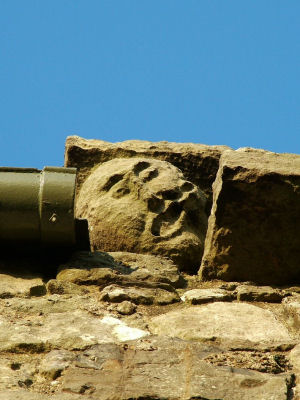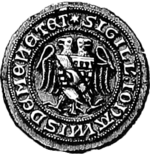John de Menteith facts for kids
Quick facts for kids
John de Mentieth
|
|
|---|---|

|
|
| Personal details | |
| Born | c.1274 |
| Died | c.1329 |
Sir John Menteith (around 1275 – around 1329) was an important Scottish nobleman. He lived during the Wars of Scottish Independence, a time when Scotland fought for its freedom from England.
John Menteith is mostly known for capturing William Wallace in 1305. Wallace was a famous Scottish leader. Later, John Menteith joined forces with King Robert I of Scotland. For his help, he received large areas of land in Knapdale and Kintyre. He was also called a "guardian" of the Earldom of Menteith. This was because his young great-nephew, Alan II, was too young to rule at the time.
Contents
John Menteith's Early Life
John was the younger son of Walter Bailloch Stewart. His mother was Mary I, Countess of Menteith, who was the daughter of Muireadhach II, the Earl of Menteith. John owned land called Ruskie in Stirlingshire.
In 1286, John joined his father, Walter Stewart, and the Bruce family in signing the Turnberry Bond. This was an important agreement made at Turnberry Castle.
Fighting for Scotland's Freedom
John and his older brother, Alexander, were part of the Scottish resistance. They fought against King Edward I of England. Both brothers were captured after the Battle of Dunbar in 1296.
Alexander was set free after he promised loyalty to King Edward. However, John stayed a prisoner at Nottingham Castle in England. He was released in August 1297. To gain his freedom, John had to promise to serve King Edward in a military campaign in Flanders.
John became the Constable of Lennox, a military leader. In 1301, he was fighting against King Edward's supporters in Lennox. In 1303, John was sent to discuss peace with the English.
By 1303, John had made peace with King Edward. He was back in Edward's good graces. In 1304, John was put in charge of the castle, town, and sheriffdom of Dumbarton. King Edward wanted to control this important castle. It was a key way to enter Scotland by sea.
The Capture of William Wallace
In August 1305, while he was in charge of Dumbarton, John Menteith was involved in a plan. He worked with Aymer de Valence and Robert Clifford. They met at a church in Rutherglen to capture Sir William Wallace. The plan was to hand Wallace over to John Segrave, who was the Captain of Scotland.
For this act, John Menteith was promised land and titles. However, many Scots saw him as disloyal. He was given the nickname Fause Menteith, which means "Menteith the treacherous" or "false Menteith."

A writer named Wyntoun wrote about this in 1418:
Schyre Jhon of Menteith in tha days
Tuk in Glasgow William Walays;
And sent hym until Ingland sune,
There was he quartayrd and undone.
Another writer, Piers Langtoft, said that Menteith found Wallace's hiding place. He learned about it from Jack Short, who was Wallace's servant. Langtoft wrote that Menteith came at night and captured Wallace while he was in bed. Wallace was then sent to King Edward and later killed in London.
Later Life and Loyalty to Robert the Bruce
In September 1305, John Menteith was chosen to represent Scottish nobles in a parliament in London. He was also part of the Scottish council that helped John of Brittany, the new Guardian of Scotland, who was working for English interests. On June 1, 1306, King Edward gave John the Earldom of Lennox. On June 15, he was made the Warden of Dumbarton Castle for life. John returned to Scotland in October.
In December 1307, King Edward asked John to help fight against Robert de Brus, who was leading a revolt. However, John left his earldom of Lennox and joined Robert the Bruce instead.
King Robert I of Scotland rewarded John with large land grants in Knapdale and Kintyre. In March 1308, John was among the Scottish nobles who wrote to King Philip IV of France on behalf of Scotland. In 1309, he was sent with Sir Nigel Campbell to talk with Richard de Burgh, the Earl of Ulster. John's lands in England were taken away because he had switched sides.
In 1316, John was asked to work with Thomas Randolph, Earl of Moray. Their job was to arrange a truce, or temporary peace, between Robert the Bruce and the English. John stayed close to the king's court. He signed many important documents. He was at the Arbroath parliament in April 1320. He also signed the Declaration of Arbroath, a famous letter sent by Scottish nobles to Pope John XXII.
John was one of the people who negotiated a thirteen-year truce between Bruce and the English. This truce was signed on May 30, 1323. He was also at a Scottish council meeting in Berwick in June. The last records of land given to him are from 1329. This was during the time when King David II of Scotland was still a child.
Family
John Menteith had children with a wife whose name is not known:
- Sir John de Menteith the younger, who married Helen, the daughter of Gartnait, Earl of Mar.
- Walter Menteith.
- Johanna Menteith, who married four times:
* First to Malise, 7th Earl of Strathearn. * Second to John Campbell, Earl of Atholl. * Third to Maurice de Moravia, Earl of Strathearn. * Fourth to William de Moravia, 5th Earl of Sutherland.


